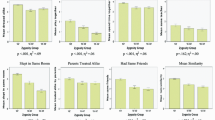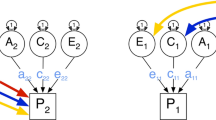Abstract
The equal-environment assumption (EEA), upon which twin methodology is based, was examined for the impact of physical similarity on phenotypic resemblance in five common psychiatric disorders: major depression, generalized anxiety disorder, phobia, alcoholism, and bulimia. A population-based sample of 882 female-female twin pairs of known zygosity was rated for similarity of appearance by color photographs. Psychiatric diagnoses were made by clinical assessment of personal interviews of the twins. Structural equation modeling of the data using physical similarity as a form of specified common environment provided no evidence for a significant effect of physical resemblance on concordance for major depression, generalized anxiety disorder, phobia, and alcoholism, thereby supporting the validity of the EEA in twin studies of these disorders. Results for bulimia, on the other hand, suggest, within the limitations of this study, that physical similarity may significantly influence twin resemblance for this disorder.
Similar content being viewed by others
References
Akaike, H. (1987). Factor analysis and AIC.Psychometrika 52:317–332.
American Psychiatric Association (1980).Diagnostic and Statistical Manual of Mental Disorders, 3rd ed., American Psychiatric Association, Washington, DC.
American Psychiatric Association (1987).Diagnostic and Statistical Manual of Mental Disorders, rev. 3rd. ed., American Psychiatric Association, Washington, DC.
Clifford, C. A., Hopper, J. L., Fulker, D., and Murray, R. M. (1984). A genetic and environmental analysis of a twin family study of alcohol use, anxiety, and depression.Genet. Epidemiol. 1:63–79.
Falconer, D. S. (1989).Introduction to Quantitative Genetics, 3rd ed., John Wiley and Sons, New York.
Goodman, R., and Stevenson, J. (1989). A twin study of hyperactivity. II. The aetiological role of genes, family relationships and perinatal adversity.J. Child Psychol. Psychiat. 30:691–709.
Heath, A. C., Jardine, R., and Martin, N. G. (1989). Interactive effects of genotype and social environment on alcohol consumption in female twins.J. Stud. Alcohol 60:38–48.
Kaprio, J., Koskenvuo, M., and Rose, R. J. (1990). Change in cohabitation and intrapair similarity of monozygotic (MZ) cotwins for alcohol use, extraversion, and neuroticism.Behav. Genet. 20:265–276.
Kendler, K. S. (1983). Overview: A current perspective on twin studies of schizophrenia.Am. J. Psychiatry 140:1413–1425.
Kendler, K. S. (1993). Twin studies of psychiatric illness: current status and future directions.Am. Gen. Psychiatry 50:905–914.
Kendler, K. S., Heath, A. C., Martin, N. G., and Eaves, L. J. (1986). Symptoms of anxiety and depression in a volunteer twin population: The etiologic role of genetic and environmental factors.Arch. Gen. Psychiatry 43:213–221.
Kendler, K. S., MacLean, C. J., Neale, M. C., Kessler, R. C., Heath, A. C., and Eaves, L. J. (1991). The genetic epidemiology of bulimia nervosa.Am. J. Psychiatry 148:1627–1637.
Kendler, K. S., Neale, M. C., Kessler, R. C., Heath, A. C., and Eaves, L. J. (1992a). The genetic epidemiology of phobias in women: The inter-relationship of agoraphobia, social phobia, situational phobia and simple phobia.Arch. Gen. Psychiatry 49:273–281.
Kendler, K. S., Neale, M. C., Kessler, R. C., Heath, A. C., and Eaves, L. J. (1992b). Generalized anxiety disorder in women: a population based twin study.Arch. Gen. Psychiatry 49:267–272.
Kendler, K. S., Neale, M. C., Kessler, R. C., Heath, A. C., and Eaves, L. J. (1992c). A population based twin study of major depression in women: The impact of varying definitions of illness.Arch. Gen. Psychiatry 49:257–266.
Kendler, K. S., Heath, A. C., Neale, M. C., Kessler, R. C., and Eaves, L. J. (1992d). A population-based twin study of alcoholism in women.JAMA 268:1877–1882.
Kendler, K. S., Heath, A. C., Neale, M. C., Kessler, R. C., and Eaves, L. J. (1993). A test of the equal-environment assumption in twin studies of psychiatric illness.Behav. Genet. 23:21–27.
Kendler, K. S., Neale, M. C., Kessler, R. C., Heath, A. C., and Eaves, L. J. (1994). Parental treatment and the equal-environment assumption in twin studies of psychiatric illness.Psychol. Med. 24:579–590.
Loehlin, J. C., and Nichols, R. C. (1976).Heredity, Environment and Personality: A Study of 850 Sets of Twins, University of Texas Press, Austin.
Lykken, D. T., McGue, M., Bouchard, T. J., and Tellegen, A. (1990). Does contact lead to similarity or similarity to contact?Behav. Genet. 20:547–561.
Lytton, H. (1977). Do parents create, or respond to, differences in twins?Dev. Psychol. 13:456–459.
Martin, N. G., Eaves, L. J., Heath, A. C., Jardine, R., Feingold, L., and Eysenck, H. J. (1986). Transmission of social attitudes.Proc. Natl. Acad. Sci. 83:4364–4368.
Matheny, A. P., Jr. (1979). Appraisal of parental bias in twin studies: Ascribed zygosity and IQ differences in twins.Acta Genet. Med. Gemmellol. 28:155–160.
Matheny, A. P., Jr., Wilson, R. S., and Dolan, A. B. (1976). Relations between twins' similarity of appearance and behavioral similarity: Testing an assumption.Behav. Genet. 6:343–351.
Morris-Yates, A., Andrews, G., Howie, P., and Henderson, S. (1990). Twins: A test of the equal environments assumption.Acta Psychiatr. Scand. 81:322–326.
Munsinger, H., and Douglass, A., II (1976). The syntactic abilities of identical twins, fraternal twins, and their siblings.Child Dev. 47:40–50.
Neale, M. C. (1991).Statistical Modelling with Mx, Department of Human Genetics, Medical College of Virginia, Virginia Commonwealth University, Richmond.
Neale, M. C., and Cardon, L. R. (1992)Methodology for Genetic Studies of Twins and Families, Kluwer Academic, Dordrecht, The Netherlands.
Plomin, R., Willerman, L., and Loehlin, J. C. (1976). Resemblance in appearance and the equal environments assumption in twin studies of personality traits.Behav. Genet. 6:43–52.
Robins, L. N., and Helzer, J. E. (1985).Diagnostic Interview Schedule (DIS): Version III-A, Washington University School of Medicine, St. Louis, MO.
Rose, R. J., Kaprio, J., Williams, C. J., Viken, R., and Obremski, K. (1990). Social contact and sibling similarity: Facts, issues, and red herrings,Behav. Genet. 20:763–778.
Scarr, S. (1968). Environmental bias in twin studies.Eugen. Q. 15:34–40.
Scarr, S., and Carter-Saltzman, L. (1979). Twin method: Defense of a critical assumption.Behav. Genet. 9:527–542.
Spence, J. E., Corey, L. A., Nance, W. E., Marazita, M. L., Kendler, K. S., and Schieken, R. M. (1988). Molecular analysis of twin zygosity using VNTR DNA probes.Am. J. Hum. Genet. 43(3):A159 (abstract).
Spitzer, R. L., Williams, J. B., and Gibbon, M. (1987).Structured Clinical Interview for DSM-III-R, Biometrics Research Department, New York State Psychiatric Institute. New York.
Author information
Authors and Affiliations
Rights and permissions
About this article
Cite this article
Hettema, J.M., Neale, M.C. & Kendler, K.S. Physical similarity and the equal-environment assumption in twin studies of psychiatric disorders. Behav Genet 25, 327–335 (1995). https://doi.org/10.1007/BF02197281
Received:
Accepted:
Issue Date:
DOI: https://doi.org/10.1007/BF02197281




